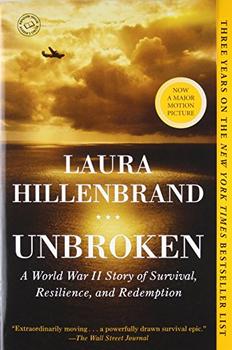Summary | Excerpt | Reading Guide | Reviews | Beyond the Book | Read-Alikes | Genres & Themes | Author Bio

A World War II Story of Survival, Resilience, and Redemption
by Laura HillenbrandThis article relates to Unbroken
Much of Unbroken relays Louis Zamperini's experiences as a Japanese prisoner of war. Hillenbrand cites staggering statistics. Zamperini was but one of approximately 132,000 POWs from the United States, Britain, Canada, New Zealand, Holland and Australia. More than a quarter of these prisoners died, including 12,935 Americans (more than 37 percent of Americans captured by the Japanese). These numbers don't include the thousands of Chinese who were murdered, nor those prisoners killed after surrender but before reaching the POW camps (for example, those who perished along the sixty-mile Bataan Death March in the Philippines). By comparison, only 1 percent of Americans held by the Nazis and Italians died during WWII.
While there were certainly Japanese guards who tried to help their prisoners, Japanese culture predisposed many toward excessive abuse of their captives. Japanese children were taught that as a people specially blessed by their sun goddess Ama-terasu Omikami it was their destiny to rule over all other countries, and that they were therefore superior to citizens of other nations. In addition, Japanese soldiers were themselves physically abused by those of higher rank throughout their training; slapping was routine, and beatings were a common, sometimes daily occurrence. Soldiers were taught to believe that surrendering cast great shame not only on themselves but also on their families (including the memories of their ancestors), and that it would be far better to die in combat than to allow themselves to be captured. These factors–along with increasing frustrations as Japan began to lose the war--led them to look on their prisoners with disgust and helped them rationalize their brutal treatment.
Zamperini was regularly beaten unconscious, starved, tortured, forced into hard labor and participation in medical experiments, and allowed to suffer from easily treatable diseases. And yet, while his tale is unique in many ways, his experiences as a POW weren't unusual. Stories abound of unbelievable cruelty inflicted on captives in the Pacific Theater during WWII. For example,
Hillenbrand reports that an airman, Raymond "Hap" Halloran, "was beaten by a mob of civilians, then captured by Japanese authorities, who tortured him, locked him in a pig cage, and held him in a burning horse stall during the firebombings. They stripped him naked and put him on display at Tokyo’s Ueno Zoo, tied upright in an empty tiger cage so civilians could gawk at his filthy, sore-encrusted body. He was starved so severely that he lost one hundred pounds."
Ben Steele, one of the soldiers whose suffering is chronicled in Tears in the Darkness: The Story of the Bataan Death March and Its Aftermath (2009) relayed many horrors, including a weeks-long journey in the overcrowded, airless hold of a Japanese "hell ship" during which many Americans and Filipino soldiers  died from starvation, lack of water, lack of air and lack of treatment for minor wounds. Steele, as well as other POW artists such as Jack Bridge Chalker, Philip Meninsky, Ashley George Old, and Ronald Searle surreptitiously recorded life in the POW camps, using whatever materials they could scrounge up (human hair, blood, plants, and scraps of paper). Some of their works were used as evidence during Japanese war crime trials.
died from starvation, lack of water, lack of air and lack of treatment for minor wounds. Steele, as well as other POW artists such as Jack Bridge Chalker, Philip Meninsky, Ashley George Old, and Ronald Searle surreptitiously recorded life in the POW camps, using whatever materials they could scrounge up (human hair, blood, plants, and scraps of paper). Some of their works were used as evidence during Japanese war crime trials.
More links:
The website for Tears in the Darkness - scroll to the bottom of the page for drawings of the Bataan Death March by Ben Steele.
Drawings by Jack Bridge Chalker while a Japanese POW working on the Burma–Thailand Railway.
Drawings by Ronald Searle from his three years as a Japanese POW building the Bridge over the River Kwai (scroll to the bottom of the page).
Image by Ronald Searle (click image for larger version). The caption reads, "Ronald Searle made this drawing under the eyes of the Japanese guards and buried it with others to escape confiscation" (image reproduced with permission of the author and The Sayle Literary Agency.)
![]() This article relates to Unbroken.
It first ran in the January 13, 2011
issue of BookBrowse Recommends.
This article relates to Unbroken.
It first ran in the January 13, 2011
issue of BookBrowse Recommends.
Your guide toexceptional books
BookBrowse seeks out and recommends the best in contemporary fiction and nonfiction—books that not only engage and entertain but also deepen our understanding of ourselves and the world around us.